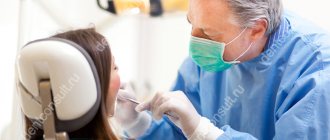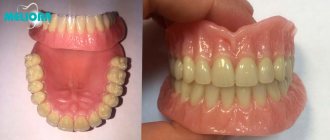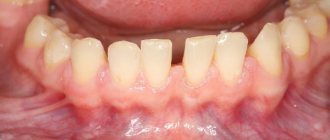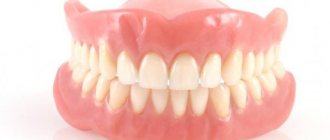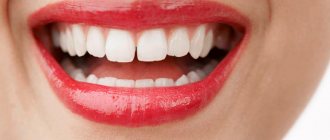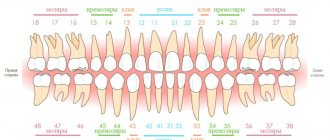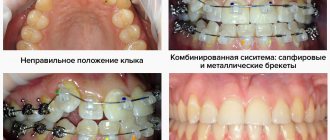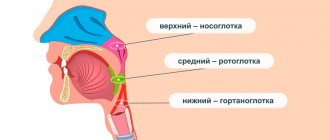Taking an impression is the most important stage of many dental procedures: diagnostic, orthodontic (bite correction), orthopedic (crowns, bridges, implantation, cosmetic restoration of teeth).
If we use an analogy with photography, a cast (impression) is a negative photograph of the dentition, with all its advantages and disadvantages. Only it is not flat, but three-dimensional, three-dimensional. By filling this three-dimensional negative with plaster or other special material, using it as a mold, the dentist receives a three-dimensional model of the upper or lower jaw.
The purpose of a diagnostic cast is to create a model of the dentition. Not all the necessary information can be obtained by examining the oral cavity. The model will allow the dentist to understand and take into account the individual characteristics of the position of the teeth, dental arches, possible anomalies (for example, diastema - a gap between the teeth, etc.), tissue relief and much more.
Once the impression is received, it is sent to the laboratory, filled with plaster and a diagnostic three-dimensional model is obtained, usually of both jaws. Both jaw models are installed in a special device (articulator), which simulates the movements of the jaws during chewing.
The diagnostic model is useful when communicating between a doctor and a patient, because you can clearly demonstrate existing problems and jointly discuss a way out of the situation. Using the model, you can explain to the patient the validity of a particular decision made by a doctor. You cannot do without a diagnostic model when correcting your bite or making prosthetics.
Materials and types of diagnostic casts
Materials
To obtain a diagnostic impression, medical plaster and more modern plastic materials (thermoplastic and elastic masses) are used, which are able to acquire the shape of the dentition and maintain it.
All materials from which the impressions are made do not cause allergies. They are divided into several types:
- Hard (gypsum, dentol). They reproduce the texture of fabrics well, are easy to use, but are excessively rigid. Because of this, imprints of areas of the tooth located closer to the gum are not always successful.
- Elastic (silicone, alginate, etc.). To enhance the strength of the impression mass, special fillers are added to it. When heated, such an impression mass becomes softer and recreates the contours of tissues well. Disadvantage: elastic impressions are not suitable for long-term storage, unlike hard ones. For example, silicone impressions shrink within 3 hours after the impression. The model must be manufactured strictly within this period of time.
- Thermoplastic (gutta-percha, Kerr mass). The material becomes plastic when heated and hardens after cooling. Advantages of this type of casts:
- good separation from plaster during model making;
- Possibility of repeated administration into the oral cavity.
Types of casts
Compression . Made for the lower jaw. Purpose - to determine the distribution of load during chewing for the future prosthesis. Requires materials of high viscosity.
Unloading . They are used in the preparation of prosthetics for people whose activities are related to oral speech. When chewing, the load will be distributed unevenly.
Combined . With their help, dentures are made that evenly distribute the load both during eating and when talking.
Taking a diagnostic impression
The oral cavity must be prepared
Having agreed with the patient on the type of prosthesis, selecting the materials for the impression and the necessary tools, the prosthetist begins the procedure of taking the impression. It begins with an examination of the oral cavity and determining whether individual teeth require extraction or treatment.
If there are bone growths (exostoses) in the place of the former lateral chewing teeth, the doctor will have to remove them. The oral cavity is thoroughly dried with cotton swabs or a special dental gun. Now it’s time to start selecting a spoon, an instrument with which the impression mass is introduced into the oral cavity.
Spoon selection
Selecting a tray is an important step as there are several types of impression trays. They differ:
- Size . For jaws and dentition of different lengths, sizes and shapes, teeth of different heights, a suitable spoon is required. A standard set of spoons is not suitable in all cases. Sometimes you have to make a spoon individually.
- Material. Spoons come in metal and plastic, with different hardnesses.
- By appointment . A special tray is used to take an impression of the lower or upper jaw.
- A type of cast . Separate trays are provided for compression and decompression (without pressure on the gum) impressions.
Preparing the impression material, applying the material to the tray and taking the impression
Having selected the correct spoon, the prosthetist begins mixing the impression mass. The prepared mass is placed on a spoon, then, using a spoon, into the oral cavity. The spoon is positioned and pressed first in the area of the chewing teeth, then in the frontal teeth. Without waiting for hardening, the prosthetist removes the spoon from the mouth very carefully so as not to damage the impression.
Two-stage and one-stage method of taking an impression
With the two-stage method, the impression is made in two steps. First, the main impression material is introduced, the first impression is made, and dried. Then a corrective composition is applied to it and the impression is made again.
The one-step method involves simultaneous application of the main mass and the corrective composition to the spoon.
The finished impression remains to be washed, disinfected and sent to the denture laboratory for the production of a diagnostic model.
Individual spoons
INTRODUCTION
One of the stages of any orthopedic treatment is taking an impression. An impression is a negative image of the prosthetic bed and adjacent areas. The impression is obtained using special trays that perform a forming function. According to the degree of compliance with the prosthetic bed, spoons are divided into individual and standard. Individual trays provide a more precise fit to the prosthetic bed and can be used for any type of removable prosthetics when it is necessary to obtain a functional impression.
- Individual spoons.
Custom trays provide an even more precise fit to the prosthetic bed. The marginal gap between the tray and the prosthetic bed can be set arbitrarily
There are many techniques for making custom spoons, but most of them are not used in practical healthcare. Methods can be divided into: direct, in which the doctor makes a spoon directly in the patient’s mouth and takes an impression in one visit; and indirect (extraoral, laboratory) - with preliminary receipt of the model and the participation of a dental technician.
In recent years, preference has been given to laboratory methods for the manufacture of individual spoons, which in turn can be divided into: production directly on the model and using a mold:
- production on a plaster model by palpation compression of self-hardening plastic in the dough-like stage;
— a technique for compression pressing of plastic, which involves wax modeling of a spoon, the use of detachable molds and the use of polymerization techniques (high or low temperature);
— injection molding technique – the difference from the previous one is the use of a syringe press and a special cuvette with sprue channels;
— a vacuum pressing technique using special molds and blanks-plates of thermoplastic polymers of various thicknesses, which are compressed according to the model and cut along the boundaries;
— production of light-curing polymers from standard plates. The plate is crimped according to the model and polymerized in a special box;
- a technique for making spoons using bulk modeling technology - applying polymer powder to the surface of a plaster model, followed by impregnation with liquid monomer until saturation and polymerization in a pneumatic polymerizer at 3 atm.
II. Features of manufacturing individual trays for obtaining differentiated functional impressions in patients with complete absence of teeth.
In order to reduce the intensity of atrophic processes, increase the functional value of the lamellar prosthesis, and shorten the adaptation period by creating conditions for a more uniform distribution of chewing loads, various techniques are used to achieve the assigned tasks. In particular, a more serious attitude towards obtaining a preliminary alginate impression, methods for creating a volumetric edge of the prosthesis at the stage of manufacturing an individual tray (IT) and obtaining a differentiated functional suction impression.
Due to the increasing demands on the aesthetics and functionality of dentures, the attitude towards impressions moves to a qualitatively different level. More and more often in the scientific literature there are phrases about the need to use a functional suction impression in orthopedic practice. It is considered an unacceptable mistake to make complete removable dentures using preliminary alginate impressions.
To obtain a high-quality impression and guaranteed success in prosthetic restoration of toothless jaws, it is necessary to produce an IL. Nowadays, spoons are often made directly on the model and it is more correct to call them a base spoon rather than an individual spoon [.
With the advent of new materials and technologies, the IL manufacturing process has followed several development paths:
1. Production of IL using cold polymerized plastics.
2. Production of IL using solar-cured materials.
3. Use of thermoplastic materials.
It is possible to make IL from colorless transparent plastic to visually identify areas of increased pressure on individual parts of the prosthetic bed.
TECHNIQUE: After receiving alginate preliminary impressions and drawing the approximate boundaries of the IL on them with a chemical pencil, it is necessary to cast the primary plaster models for making the IL.
The chemical contour previously applied to the preliminary alginate impression by the doctor will appear on the model. It will serve as a useful guide in the production of IL.
To produce functional IL, it is necessary to adhere to the following basic principles:
1. The outer edge of the IL should have a thickness of 3 - 4 mm (to obtain a voluminous outer border of the prosthesis and better fixation of the edging material)
2. The edge of the IL should not reach the transitional fold by 2 mm, and in the area of cords and frenulums by 3-4 mm,
3. IL it is necessary to obtain a differentiated functionally suction impression, which will provide selective load on individual areas of the prosthetic bed depending on their functional endurance.
4. During functional tests, the IL handle and the fingers holding it should not interfere with or distort the formed contours.
5. The IL for the lower jaw should be thicker than the upper jaw to avoid deformation during impression taking (especially with a severely atrophied alveolar process).
One of the difficult areas when obtaining a functional impression is the area in the area of line “A” (“vibrating zone”), since there is no transitional fold here, and the stationary mucous membrane of the hard palate smoothly passes into the mucous membrane of the soft palate. As a result of incorrect definition of this boundary, the upper complete removable denture has unsatisfactory fixation and easily tips over when biting food. When analyzing the causes of this phenomenon, weakness of the closing valve along the posterior border of the prosthesis is revealed. It is well known that to obtain a good distal valve, it is necessary to lift the soft palate in a slightly elevated position. This can be achieved by adding a wax plate to the posterior edge of the IL.
To solve this problem, many people use the technique of cutting plaster on a preliminary model along the posterior border of the prosthesis. The essence of this technique is as follows: draw on the model the boundaries of the paratorussal region that require engraving (the posterior border is 2 - 3 mm distal to line “A”, the anterior border is not reaching the distal edge of the torus and moving forward 5 - 8 mm on both sides from the median suture, smoothly reaching the pterygomaxillary notches). At the same time, in the area of the pterygomaxillary recesses and the median suture, plaster is removed to a depth of 0.5 mm, and in more pliable zones by 1 - 1.5 mm, ensuring a smooth transition between zones. This technique promotes some compression of the passively mobile mucous membrane with an individual spoon, which subsequently creates a stable circular valve of the prosthesis and eliminates the further stage of applying material to the distal edge of the IL.
Atrophic processes in the tissues of the prosthetic bed of toothless jaws are irreversible, and when using removable dentures, they intensify due to excess pressure on the supporting tissues, especially the alveolar process. Our main task in prosthetics is to slow down this process as effectively as possible in various ways. One of the most accessible and effective methods is to obtain differentiated functional impressions. As a result, chewing pressure is evenly transmitted through the prosthesis base to the tissues of the prosthetic bed. It is very difficult to achieve this effect, due to the unequal compliance of the mucous membrane of the tissues of the prosthetic bed. A uniform load on the mucous membrane is possible only if the prosthesis base initially compresses the mucous membrane in areas of the most pliable tissue, then in less pliable areas, and at the very last moment in areas of almost inflexible mucous membrane.
According to S.A. Gushchina, the average digital indicators of compliance of the mucous membrane of the upper jaw are such that the zone of the alveolar ridge and the median suture has relatively uniform compliance (0.81 for the zone of the alveolar ridge and 0.8 for the median suture). The compliance of the mucous membrane in the zone of transition of the alveolar ridge to the palatine vault is, on average, 1.5 times greater than in the zone of the alveolar ridge and the median suture, that is, the difference in the compliance of the mucous membrane in the adjacent zones of the alveolar ridge, transition zone and the zone of the median seam is on average 0.4 - 0.5 mm.
Thus, in order to equalize the compliance of the mucous membrane of the prosthetic bed, the following equation must be observed: the thickness of the insulation is equal to the difference in the compliance indicators of the border zones. For example, the thickness of the insulation (0.4 mm) is equal to the difference between the compliance index in the zone of transition of the alveolar ridge to the palatine vault (1.2 mm) and the compliance index in the alveolar ridge zone (0.8 mm).
Based on the above data, it is possible to isolate poorly pliable areas of the mucous membrane of the prosthetic bed with a plate of clasp wax (0.5 mm thick), but we recommend using at least two, and if there is significant pliability, using three or more.
Low-compliance areas of the oral mucosa can be determined individually using the Lira-100 apparatus with a special sensor (Bankov V.I., Zholudev S.E., Lugansky V.A.), or you can use the approximate boundaries of zones with varying degrees of compliance based on the data many authors, while the latter method will be less effective.
Using any of the available methods, we identify the boundaries of the zones of least compliance or approximately mark them on the models. On the upper jaw these are: the apex of the alveolar process, the tubercle of the upper jaw, the area of the median suture, it is better to include transverse folds in the insulation.
On the lower jaw these are: the apex of the alveolar process, the internal oblique line, exostoses, the mental spine, while the mucous tubercles are not covered with wax.
Before the actual production of IL, it is necessary to prepare plaster models as follows:
The entire working surface of the model is covered with a thin insulating layer of Vaseline and, carefully, so as not to thin it, is crimped on one side with a plate of clasp wax, slightly heated over a burner flame.
Then part of the wax is cut out with a scalpel and removed in such a way that on the upper jaw the remaining wax covers the apex of the alveolar process, the internal and external slope to the border of the IL, the torus area and transverse folds. There is no insulation in the paratorussal region (buffer zone and along the posterior border).
On the lower jaw, wax lies on the top of the alveolar process, the internal oblique line (with a sharp ridge), exostoses, and the mental spine, while the mucous tubercle is not covered with wax.
In other words, wax is absent from areas with pliable mucosa and remains in areas with less pliable oral mucosa.
One of the most important conditions for successful prosthetics in the absence of teeth is obtaining a high-quality functional impression that ensures retention of the prosthesis. To do this, the impression must record not only the depth of the anatomical grooves, but also their width. In other words, the boundaries of the functional impression must be three-dimensional.
To obtain a volumetric edge of the IL, use the following technique:
Along the transitional fold, resting against the end of the compensatory strip of clasp wax, we apply a strip of base wax (3-5 mm wide and 2 mm thick) to the model from the side of the movable mucous membrane. Moreover, the inner edge of the base wax strip should be at an angle of 90 degrees to the alveolar process.
Next, IL is made from self-hardening plastic or standard blanks. It is necessary that its vestibular and buccal edges overlap the inner edge of the strip of base wax by 1-2 mm, while the thickness of the IL in the area of overlap is 2-3 mm. Thanks to this, a thickened edge of the IL is guaranteed. At the same time, it is necessary that the transition of the IL from the outside to the wax plate be in the form of a gentle slope, and not in the form of a sharp step.
The internal ledge formed in this case acts as a limiter on the length of the edge of the spoon, which further facilitates the fitting of the IL, since its excessive elongation is excluded.
Then an IL handle is made from small pieces of plastic dough.
The handle should be installed approximately in the same position where the front teeth will be, with the same deviation and be parallel to the lip. As a result, it will not interfere with the implementation of functional tests during the formation of boundaries. The upper end of the handle should not be curved and have a height of 20 mm. Otherwise, it will interfere with the normal position of the lips.
In addition to the handle in the anterior section of the mandibular IL, it is necessary to make bilateral finger rests in the area of the first molars, 20 mm high. The front handle is used to insert the spoon into the mouth and position it over the alveolar bone. The rear handles are used as finger rests to complete tray placement and hold the IL in the correct position, with minimal distortion of the surrounding soft tissue by the fingers as they hold the IL in place during functional testing.

